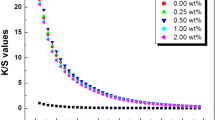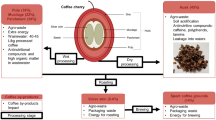Abstract
Coffee stains on textiles are mainly caused by the water-soluble and acidic colored substances in coffee. The acidic nature of coffee stain has been shown by ultraviolet and visible spectroscopy of coffee as a function of pH; ion-pair formation with a cationic surfactant and titration with Hyamine 1622 and a surfactant-specific electrode; and precipitation of the colored components in coffee with barium hydroxide as a barium salt. The permanence of coffee stains on textiles depends on the nature of the fibers. The affinity of coffee stain to fibers, indicated by resistance to detergency, increases in the order polyester<cotton<nylon. Coffee stain has little affinity to polyester fibers but adheres to cotton and even more firmly to nylon. The strong affinity to nylon and the pH dependence of staining suggest an ionic interaction of carboxyl and phenolic groups with amine end-groups in nylon. The ionic attraction is augmented by nonionic interactions that are enhanced by the oligomeric or polymeric nature of the staining substances. In accord with the dominantly acidic character of coffee stain, an alkaline medium is needed for the dislodgment of coffee stain from nylon fibers. Bleaching of coffee in solution with perborate, activated with sodiumn-nonanoyloxybenzenesulfonate, or Oxone® (DuPont, Wilmington, DE) obeys pseudo first-order kinetics. Oxone, a peroxysulfate triple salt, is a more powerful oxidant for coffee stain than sodium perborate, but its use is limited by the bleach fastness of dyes.
Similar content being viewed by others
References
Kissa, E., J.M. Dohner, W.R. Gibson and D. Strickman,J. Am. Oil Chem. Soc. 68:532 (1991).
Kissa, E.,Textile Chemist and Colorist, Vol. 27, in press (1995).
Kissa, E., inThe Analytical Chemistry of Synthetic Dyes, edited by K. Venkataraman, John Wiley & Sons, New York, 1977.
Wurziger, J.,Ullmann’s Encyclopedia of Industrial Chemistry, 4th edn., Vol. 13, Verlag Chemie, Weinheim, 1977, p. 429.
Viani, R., Ibid., 5th edn., Vol. A7, VCH Verlagsges, Weinheim, 1986, p. 315.
Wasserman, G., H.D. Stahl, W. Rehman and P. Whitman,Kirk-Othmer Encyclopedia of Chemical Technology, 4th edn., edited by Mary Howe-Grant, Vol. 6, John Wiley & Sons, New York, 1993, p. 793.
Clifford, M.N., and J.J. Wright,J. Sci. Food Agric. 27:73 (1976).
Trugo, L.C., and R. Macrae,Analyst 109:263 (1984).
Ikan, R., T. Dorsey and I.R. Kaplan,Anal. Chim. Acta 232:11 (1990).
Van den Hoop, M.A.G.T., H.P. Van Leeuwen and R.F.M.J. Cleven,Ibid.:141 (1990).
Vickerstaff, T.,The Physical Chemistry of Dyeing, 2nd edn., Oliver & Boyd, London, 1954.
Bird, C.L., and W.S. Boston (eds.),The Theory of Coloration of Textiles, The Dyers Company Publication Trust, West Yorkshire, England, 1975.
Author information
Authors and Affiliations
About this article
Cite this article
Kissa, E. Coffee stain on textiles. Mechanisms of staining and stain removal. J Am Oil Chem Soc 72, 793–797 (1995). https://doi.org/10.1007/BF02541027
Received:
Accepted:
Issue Date:
DOI: https://doi.org/10.1007/BF02541027




